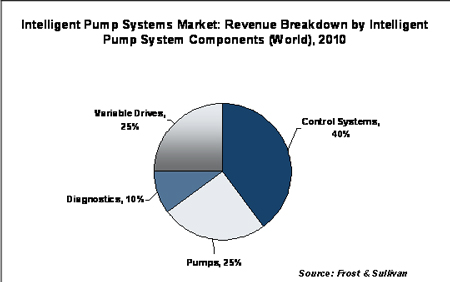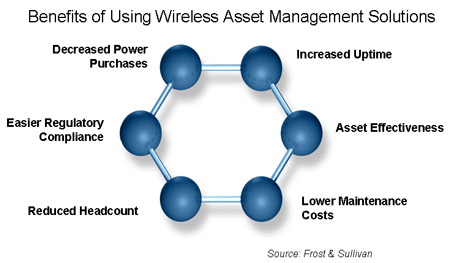Wireless control and monitoring are a vital part of pump systems.
Intelligent pump systems are pumps with built-in process controllers and pump diagnostic devices to monitor pump operating characteristics and prevent pump errors. It is the ability to adjust a pump's operations to match operating conditions that sets these pumps apart from other types of pumps. Due to this capability, these pumps can help companies reduce unplanned shutdowns and improve energy efficiency.
However, no matter how sophisticated the pump, inspections still need to be completed, records need to be kept and costs still need to be controlled. All the above actions require labor and time, adding to the overall life cycle cost of the pumping system.
One of the ways that companies can address the challenges of monitoring pump stations, lift stations and similar systems is through the use of wireless pump control and monitoring systems. These systems, which can be integrated into an end user's existing assets or into a new pump system, most often use cellular networks to transfer data between a pump or lift station and an internet-enabled computer or mobile-device.
Market Drivers for Wireless Systems
According to independent research conducted by Frost & Sullivan, control systems account for 40 percent of the revenue generated within the intelligent pumps market.
Control and monitoring equipment is a vital component to these pump systems and, as more intelligent pump systems are used in the market, the need for more advanced automation, control and monitoring systems will increase. Therefore, demand for wireless pump control and monitoring systems is directly correlated with the increasing demand for intelligent pumping solutions, and the drivers for both are similar in nature. In addition, Frost & Sullivan anticipates that the market for real-time mobile asset tracking and preventative maintenance monitoring to increase five-fold by 2020.
Currently, rising energy costs and new environmental protection regulations help drive the market for intelligent pump solutions.
These factors also influence the development of components within these solutions to contribute to energy efficiency and reduced greenhouse gas emissions. Advanced control and monitoring systems integrated into intelligent pump solutions can help end users control energy usage by adapting the pump characteristics to match operating conditions.
This energy optimization capability can save users on energy costs while helping them ensure compliance with environmental regulations. In addition, end users are looking for cost-effective solutions that lower the total life cycle costs of their equipment.
Although the initial installation costs can be high, condition monitoring systems provide users with the ability to access real-time operating data on their pumping equipment, which offsets the higher initial costs through reduced unplanned downtime and improved predictive maintenance plans.
The added benefits of wireless pump control and monitoring systems are apparent when reviewing the current challenges faced by pump system end users.
The manufacturing industry has become more globalized, with companies acquiring assets located around the world. Even on a regional level, companies often operate pump systems in difficult-to-access locations or in remote areas in which it simply is not feasible to station a full-time maintenance crew.

Wireless systems enable users to access operational data anywhere, anytime. This real-time access to monitoring data and alerts to potential problems with geographically-dispersed assets provide end users with actionable information that allows faster decision-making to take place. The ability to quickly assess a situation remotely saves users valuable time in troubleshooting and resolving problems, which can lead to substantially less unplanned downtime.
In addition, wireless systems can enhance the flow of information between one pump system or multiple pump systems, and enterprise applications help standardize communication across an enterprise by providing a single communication platform.
Wireless control and monitoring systems also help reduce the amount of labor needed to keep these stations operational.
In many cases, pump stations require personnel to physically walk the plant and perform visual inspections. Wireless control and monitoring solutions perform these tasks remotely, saving man-power and reducing paperwork through automated record-keeping.
Wireless Adoption Roadblocks
One of the reasons end users are slow to adopt wireless technology for their pump control and monitoring needs is the high initial costs of the intelligent pumping solutions for which this technology is often used.
The most effective way for manufacturers to overcome this challenge is by emphasizing the cost-effectiveness of such a solution over the long term, in terms of reduced unplanned downtimes, reduced maintenance needs, improved energy efficiency and the lower cost of installation for the wireless control system, as it does not need to be hard-wired into the existing asset management systems.
The lack of standardized communication protocols to enable wireless use across diverse end-user systems has also contributed to the slow adoption rate.
While some pump manufacturers are coming up with standard protocols, such as Profibus, the communications protocol issue is still expected to have a strong impact in the next one to two years, to be downgraded to a medium impact over the next five to seven years.
There is also, among end users, a lack of in-house knowledge to operate these systems, due to both a declined skilled labor force and a shortage of knowledge of the advanced technology used by these systems.
This opens up asset management agreement opportunities for manufacturers who are willing to invest in expanding their operations from product provider to service provider. End users are likely to prefer a company that will provide both the system and the maintenance services required to keep that system operational throughout its life.
Solutions in Action
A major utility player that generates and distributes power to over 14 million customers operates a thermal power generation portfolio of gas, nuclear and coal plants.
These plants are spread over a diverse geographic area, including some plants that the utility recently acquired. The challenges for this utility include integrating these newly acquired plants into its existing systems, decreasing unplanned shutdowns through increasing proactive maintenance and improving overall asset effectiveness.

The utility implemented a pilot program using a wireless asset condition monitoring solution at one of its main plants and outsourced the maintenance of the system to the solution provider.
The implementation of this solution enabled the utility to centralize and automate equipment monitoring on a remote basis. These capabilities to remotely detect, diagnose and prevent maintenance problems allowed the utility to use less maintenance personnel and engage in a proactive maintenance approach that actually reduced unplanned shutdowns.
Looking into the Future
As the needs for energy efficiency, real-time access to equipment data and a single platform to monitor geographically-dispersed assets continue to spur end users to seek compatible solutions, the demand for wireless pump control and monitoring systems will continue to grow. Wireless asset management solutions will continue to emerge as a vital component to developing more reliable and responsive production processes for pumps end users.
Pumps & Systems, May 2011

